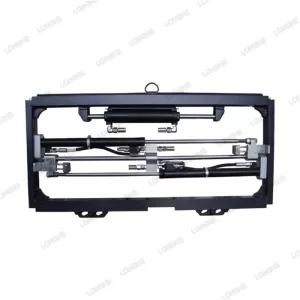Aug. 03, 2023
Mechanical Parts & Fabrication Services
Forklifts are essential tools in various industries, from warehousing and logistics to construction and manufacturing. Their efficiency and productivity are critical for smooth operations and optimal material handling. By understanding the advantages of fork positioners, businesses can maximize their forklifts' potential and gain a competitive edge in their respective industries.

Fork positioners are hydraulic attachments designed to adjust the width of forklift forks effortlessly. These attachments allow operators to control the distance between the forks, catering to the specific size of the load they need to lift. Fork positioners can move the forks closer together or farther apart, accommodating various pallet sizes and material types. The ability to adjust fork width without leaving the operator's seat significantly improves the forklift's versatility and efficiency.
One of the most significant advantages of using fork positioners is the drastic improvement in productivity. Traditionally, forklift operators had to manually adjust the forks' width using tools, costing valuable time during loading and unloading processes. With fork positioners, the process becomes seamless and swift, reducing downtime and enhancing overall operational efficiency.
Safety is paramount in any material handling operation. Fork positioners play a crucial role in enhancing safety for both the operator and the goods being transported. Manual adjustments of forks can lead to accidents, especially when handling heavy or awkwardly shaped loads. Fork positioners eliminate the need for manual intervention, minimizing the risk of mishaps and injuries.
Different loads require different fork widths to ensure stability and balance during transportation. Fork positioners provide unparalleled flexibility and versatility, allowing operators to adjust the forks to fit various load sizes and shapes quickly. This adaptability enhances the forklift's capability to handle a diverse range of materials, making it an invaluable asset in dynamic warehouse environments.
Improperly adjusted forks can lead to product damage during handling. Fork positioners ensure that the forks are set at the ideal width to support the load securely and minimize the risk of damage. By reducing product damage, businesses can cut down on operational costs and maintain a positive reputation for delivering intact goods to their customers.
Fork positioners contribute to improved operator comfort and efficiency. Operating a forklift with manual fork adjustments can be physically demanding and lead to operator fatigue. With fork positioners, the operator can make precise adjustments from within the cab, eliminating the need for strenuous physical exertion. As a result, operators can stay focused and alert, leading to better overall performance.
Though investing in fork positioners may seem like an upfront cost, the long-term benefits outweigh the initial expenditure. Improved productivity, reduced product damage, and enhanced safety all contribute to significant cost savings in the long run. Businesses can also witness a substantial increase in their return on investment (ROI) due to the heightened efficiency and reduced operational downtime.
Fork positioners can be easily installed on various forklift models, making them highly compatible with existing equipment. The seamless integration ensures a smooth transition to the enhanced forklift functionality without major disruptions to ongoing operations. This adaptability allows businesses to upgrade their material handling capabilities without incurring additional expenses for new forklifts.
In conclusion, fork positioners offer a wide range of advantages that significantly enhance forklift operations. From improved productivity and safety to flexibility and cost-effectiveness, these hydraulic attachments revolutionize the way materials are handled in diverse industries. Investing in fork positioners is a strategic move for businesses seeking to optimize their material handling processes and gain a competitive advantage in their respective markets.
So, if you want to take your forklift operations to the next level, consider integrating fork positioners into your fleet. Embrace the power of enhanced productivity, safety, and efficiency for a more successful and prosperous future.
Previous: What is aluminum extrusion?
Next: What is the difference between a slurry pump and a water pump?
If you are interested in sending in a Guest Blogger Submission,welcome to write for us!
All Comments ( 0 )